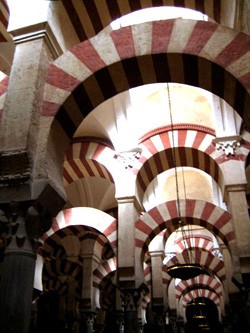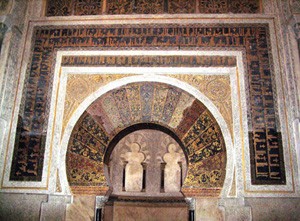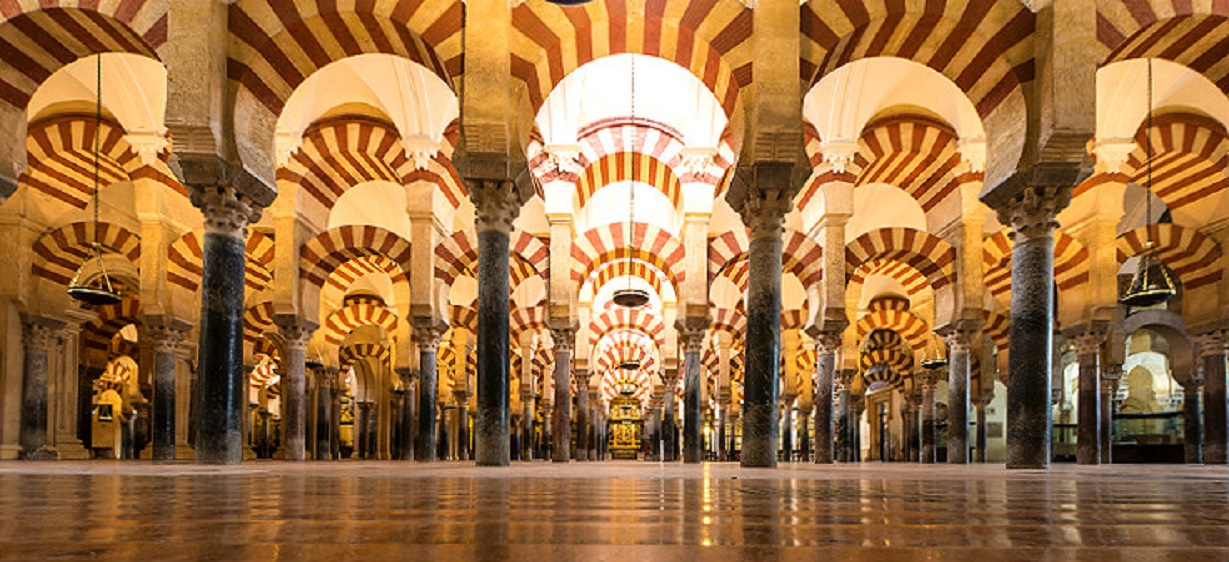Invited in 1933 by the orientalist Miguel Asín Palacios to lecture in Madrid, the preeminent Persian and Urdu poet Muḥammad Iqbāl availed himself of this opportunity to make a sojourn south to visit the Great Mosque of Cordoba. He became the first Muslim to offer prayers in the mosque since its conversion into a cathedral after the consolidation of the Christian Reconquista following the fall of Granada in 1492. By all accounts, the stirring intensity of this experience was nothing less than theatrical. Iqbāl, radically moved by the visual sumptuousness of the mosque, which he equated with an all-embracing majestic aura of Islam, and under a spell of fervent emotions coursing through him as a consequence of this encounter, apparently swooned upon entering it (Noorani 1999, 237). The eager inflections of this experience summarily gained posterity in the thematic formulations of his celebrated Urdu poem ‘Masjid-e Qurt̤uba’.
In the flight of its ruminations, in its encapsulation of the creative ethos of Islam, and in the determined swing of its cadences, ‘Masjid-e Qurt̤uba’ is a soaring enterprise. However, even while the material constitution of the Cordoba mosque, which so powerfully moved the poet, generates the primary impetus for his lyrical surge, Iqbāl’s thematic preoccupations in the poem seem to circumvent the composite visual imperatives that have informed the sequential formation of this edifice as a cultural and architectural entity. The steadfast impulse coursing through the poem tends to subsume the physicality of the mosque within Iqbāl’s overarching concerns centered on the consummate exertions of faith on the part of Arab warriors enkindled with unadulterated codes of Islamic conduct. Within the space of such imaginings, the Cordoba mosque becomes a material conduit for avowing the creative surge of the generic figure of Iqbāl’s mard-e khudā, the exemplary Man of God whose dynamic love (ʿishq), drawn from the kernel of majestic Islamic conduct, has made this expression possible. The passionate, active spirit of the mard-e khudā roves over the ornate stones of this sacred monument, and thus, for Iqbāl:
Hai magar is naqsh mēñ rañg-e ṡabāt-e davām
Jis kō kiyā hō kisī mard-e khudā nē tamām
Mard-e khudā kā ʿamal ʿishq sē ṣāḥab farōgh
ʿIshq hai aṣl-e ḥayāt maut hai us par ḥarām
(1989, 386)1
Yet, in this mark, shimmers the color of permanence and perpetuity
perfected to its zenith by the Man of God;
The act of the Man of God, resplendent with dynamic love;
Dynamic love the essence of life, on which death is forbidden
In this regard, it is nearly redundant to indicate that Iqbāl’s response to the visual splendor of the mosque can be better appreciated in an emblematic way, as an invocation of his formulated concept of Islam’s earlier glory, and a crucial need for this glory’s renaissance in the conduct of the contemporary Islamic Umma. Evidently, Iqbāl’s concerns lie far from the historical exactitude, as well as the historical compositeness, through which the architectural refinements of the Cordoba mosque may be engaged. ʿAmīq Ḥanafī makes an astute observation in his article on ‘Masjid-e Qurt̤uba’ when he says: ‘The poem under consideration is not shackled to its designation or beholden to its subject; rather, it exploits the experience of the visit to the mosque as raw material for a self-replicating creative act’ (1977, 33). Arguably then, Iqbāl’s lyrical enterprise is singular in the sense that it eschews the reckoning of this monument on the express merit of its visual constitution. And with this realization in mind, it would be worthwhile to explore the potential correspondences between his imaginings of a pan-Islamic vitality in the material elements of this monument with the architectural vicissitudes of the very same monument rooted compellingly in Andalusian historical formations. It may be prob- able that tracking the visual evolution of the Cordoba mosque will reveal an alternate paradigm, at variance with the one envisioned by Iqbāl where the incidence of this mosque is primarily an expression of the sweeping exertions of the mard-e khudā. But it is just such alternate readings of the Cordoba mosque that can endow us with the requisite agency to foreground the divergent ways in which its historical connotations may be appropriated.
In returning to the emblematic nature of Iqbāl’s engagement with the architectural or material composition of the Cordoba mosque, in suggesting that he experiences the mosque almost exclusively as a quintessence of his own disseminative vision of an Islamic cultural restoration, it is not that Iqbāl does not respond more topically to the visual quality of such Islamic monuments. But even when making more formal assessments of Islamic architecture, his sensibilities lie in valorizing a conquering vitality and a stately disposition, whose aesthetic appeal, as ʿAzīz Aḥmad states in regard to Iqbāl’s relationship with architecture, lies in an artistic expression born out of a free spirit (1968, 331). For Iqbāl, the architectural works in Delhi under Qut̤bu’d-Dīn Aibak, and later under Shēr Shāh Sūrī in the sixteenth century, epitomize this free quality where there is a commendable manifestation of Self in their makers’ architectural vision, and who, akin to the creators of the Cordoba mosque, integrate traces of their conscience and will in their works (ibid.). The Taj Mahal, it turns out, is inadequate in Iqbāl’s view, where:
The quality of Quvvatu’l-Islām [mosque] is not discernable in it. As with later buildings, an infirmity has crept into the element of its vigor, and in fact, it is this very element of vigor which institutes a balance for beauty.
(In ibid., 333)
As for Shāh Jahāñís Jāmīʿ mosque in Delhi, he quips: ‘Vō tō ēk bēgam hai’ (It is merely a begum) (ibid.). In a similar vein, the Alhambra palace in Granada fails to elicit an enthusiastic response from Iqbāl for he equates its visual expression with the frailty which has crept into its Islamic elements; according to him, a triumph of dynamic human selfhood is utterly subdued in the Alhambra. He is reported to have said:
I kept straying here and there in the halls and porticos of the Alhambra, but wherever I raised my eyes, I saw huā ghālib [He is victorious] inscribed on the walls. I said to myself that everywhere here, it is solely the Almighty whose triumph is proclaimed; if only the triumph of Man too was visible here, then it would be something.
(ibid.)
Clearly then, Iqbāl’s responses to Islamic architecture draw their insights from an ideological space upholding masculine vigor and majestic bearing envisioned as prime constituents of Islamic cultural rejuvenation. They advocate verve, reflecting the selfhood of their executors; ultimately, it is the presence of the palpable exertions of the mard-e khudā in an architectural edifice that bestow upon it an enduring worth.
But within a broader framework, while reflecting on the quality of Islamic architecture, if Iqbāl’s exhortations to revitalize an Islamic Renaissance partake of a more wide-ranging Romantic moment of the late nineteenth and early twentieth centuries, they concurrently delineate a retort-laden discourse against the colonizing maneuverings of the West. Consistently, Iqbāl’s experience of Islamic architecture seems to weave in concerns emerging from the colonial situation. While his experience embraces a monument as an embodiment of universal Islamic ideals that he seeks to espouse, it is also capable of rejecting a monument as a lamentable expedient contaminated by the intrigues of the colonial West. Nowhere is the resistance to the colonial situation voiced more aggressively in Iqbāl’s evaluation of Islamic buildings than in his perceptibly belligerent tone in the verses dedicated to another mosque, the Mosque of Paris, where he says:
Ḥaram nahīñ hai, firañgī karishma bāzoñ nē
tan-e ḥaram mēñ čhupā dī hai rūḥ-e butkhāna
Ye butkadah inhīñ ghārat-garoñ kī hai taʿmīr
damishq hātẖ sē jin kē huā hai vīrānā
(1989, 565)
It is not a sanctuary; the miracle-touting Europeans
have concealed the soul of an idol-house in the body of the
sanctuary
This idol-house, a creation of the very same plunderers
at whose hands Damascus has become a wasteland.
Of course, Iqbāl’s polemic here is directed at the early twentieth- century French policies in Syria, which have debased the superlative integrity of Damascus—the urban locus representing an Islamic mode of existence—and turned it into a wasteland. With such happenings to reckon with, the creation of these miracle-peddling firañgīs, even if it were a mosque, cannot be worthy of appreciation for it harbors the sullied aura of its exploitive creators.
An identifiable aspiration for an Islamic cultural renaissance, lodged as a corrective against the interventions made by the colonial situation, resounds in ‘Masjid-e Qurt̤uba’ If Iqbāl, in the poem, traverses the past and the future through a firm anchoring to the present, as ʿAmīq Ḥanafī suggests (1977, 34), then the Cordoba mosque, as an aesthetic emblem reifying the magnificence of the past civilization of Islam, animates a moral and political commentary rooted in Iqbāl’s own time and milieu. As Yaseen Noorani observes in his ‘The Lost Garden of Al-Andalus,’ the colonial situation is as responsible for inspiring the thematic formulations of the poem as the splendors of Islamic Spain. The poem’s critical momentum derives from ‘a vision of cultural renaissance that negates the present political reality and elaborates a truer one that supersedes it’ (1999, 237). It is a wishful vision communicated manifestly in the culminating verses of the poem:
ʿAlam-e nau hai abhī parda-e taqdīr mēñ
Mērī nigāhōñ mēñ hai uskī saḥar bē-ḥijāb
Parda uÅẖā dūñ agar čehra-e afkār sē
Lā na sakēgā firañg mērī navāoñ kī tāb
(1989, 392)
A new world lies behind the veil of Destiny
Its dawn is unveiled in my sight
Should I lift the veil from the face of my thoughts
Europe shall not withstand the radiance of my songs.
The lyrical progression of ‘Masjid-e Qurt̤uba,’ therefore, does nothing less than lead to the vision of a new world, to the efflorescence of an unbound, de-territorialized umma, the domain of the mard-e khudā. It is embedded in a much more ubiquitous temporality than is granted to the mosque by the topical considerations of its historical and visual development.
Aptly enough, ‘Masjid-e Qurt̤uba’ inaugurates its rhythmic progression by a reflection on the transient nature of Time; it invokes the interlinked succession of day and night (silsila-e rōz-o-shab), the chiseler of events, which steadily steers all the grand marks of existence into nothingness, and thus:
Ānī-o-fānī tamām mʿaujiza-hā-e hunar
Kār-e jahāñ bē-ṡabāt, kār-e-jahāñ bē-ṡabāt
(ibid., 386)
They are all perishable, the wonders of skillfulness;
All the workings of the world are impermanent
But this transience is arrested in the profound structure of the mosque; there is a color of eternal timelessness (rañg-e ṡabāt-e davām) in its impression, brought to fulfillment by the mard-e khudā’s accomplishments, which are, in turn, a corollary of the dynamic love (ʿishq) that nourishes his exemplary conduct. We are confronted here with an ʿishq whose constitution, transcending a temporal specificity, spills over into other nameless epochs. Thus:
ʿIshq kī taqvīm mēñ ëaṣr-e ravāñ kē sivā
aur zamānēñ bẖī hēñ jin kā nahīñ kōʾī nām
(ibid.)
In love’s constitution, apart from coursing Time
there are other epochs which are yet nameless
At the outset then, there is a propensity to imagine the creation of the mosque in an ahistorical paradigm, as a labor of dynamic love which overrides the shackles of serial Time, and resides in a pure permanence fashioned by the all-encompassing imperative of ʿishq. Thus, for Iqbāl:
Ay ḥaram-e qurt̤uba ʿishq sē tērā vujūd
ʿIshq sarāpā davām jis mēñ nahīñ raft-o-būd
(ibid., 387)
Oh, sanctuary of Cordoba, from dynamic love sprouts your
existence;
Dynamic love, infinite all over, which is beyond past and present.
The more historically rooted impulses, and the potential local imperatives, which might have influenced the visual language and form of the Cordoba mosque, are outside the sphere of Iqbāl’s concerns here. Rather than tethering it to a historical specificity, the surge ofʿishq that shapes the visual majesty of the mosque, serves to de-territorialize the structure. The mosque relinquishes its locative specificity to embody a limitless pan- Islamic terrain in the proclamation: ‘is kī zamīñ bē-ḥudūd, is kā ufaq be- ṡughūr’ (its terrain unending, its horizon boundless) (ibid., 388).
In ‘Masjid-e Qurt̤uba’ thus, the mosque’s visual splendor is a conduit for the vision of a new world; it is an instrument for translating the mard-e khudā’s creative conduct into a language of splendorous visual forms.
In the wake of the above imaginings of the Cordoba mosque, the realization that this sanctuary, in its comprehensive formation, is a final product of at least four to five major extensions inspires some curiosity.2 The first two phases of the mosque’s construction, respectively under ʿAbd al-Raḥmān I in 786 and ʿAbd-al Raḥmān II ca. 836, reveal a seamless visual continuity. Here, the articulation of the plan is predicated on an established tradition of Islamic sacred structures based on a hypostyle arrangement with a series of bays and aisles structured by a procession of columns at recurring intervals. This schematic description, however, does not succeed in communicating the astounding ingenuity of the mosque’s interior space, which, in the art-historian Jerrilynn Dodd’s words, ‘explodes into a labyrinthine elevation of superimposed horseshoe shaped arches composed of voussoirs in which deep red brick and white stone alternate’ (1992, 12) (see, fig. 1). It is the frenzied symphony of these two-tiered arches that spells an original language of architectural forms for the mosque, quite distinct from the mosque’s counterparts elsewhere in the Islamic world. In this regard, the horseshoe arch, an element indigenous to Visigothic church- building traditions of pre-Islamic Spain, heralds the assimilation of a discernibly local constituent into the mosque’s vocabulary, while the practice of superimposing one arch over the other has an even earlier precedent in the Roman hydraulic structures in the region, most notably in the aqueduct at Mérida which combines superimposed arches with alternating brick and stone masonry. In this sense, it is in the adaptation of indigenous architectural elements that the Cordoba mosque brings into its orbit the cultural moorings of a heterogeneous Cordoban citizenry, an admixture of Arabs, Berbers, and a small group of fresh converts from Christianity to Islam, among others, who comprised the elements of the populace in the burgeoning Hispano-Umayyad emirate on the Iberian soil. Thus, at a prime level, a cultural memory tinged with an indigenous hue is preserved in the mosque’s visual expression.
 Fig. 1 Great Mosque of Cordoba, Sanctuary: Superimposed Arches 3
Fig. 1 Great Mosque of Cordoba, Sanctuary: Superimposed Arches 3
Also, in reference to his Umayyad lineage, ʿAbd al-Raḥmān I’s nostalgic yearning for his Syrian homeland, which he had been forced to flee in the wake of the ʿAbbasid onslaught, has been amply chronicled, most famously in his verses addressed to a lone palm tree on his estate of al- Ruṣāfa. Accordingly, scholars have postulated an evocation of ʿAbd al- Raḥmān’s cultural associations and memories in the visual forms that he reflexively privileged in the mosque as its commanding patron. In this light, the mosque of Cordoba may be read as fusing a Syrian Umayyad language of forms, especially in invoking the Great Mosque of Damascus for its spatial inspiration, with an architectural vocabulary drawn from preexisting indigenous building traditions.4 The visuality of the mosque therefore emerges as a function of impulses grounded in its founder’s dynastic evocations and aspirations, at a discrete variance with the grand creative rush of ʿishq in the endeavors of the mard-e khudā, as envisioned by Iqbāl.
The next significant addition to the Cordoba mosque, undertaken by ʿAbd al-Raḥmān III ca. 951, brings a more dramatic set of aspirations into its sphere. The meanings that accrue to the visual lexicon of this sovereign’s enlargements, notably preserved in the refurbished courtyard to the north where he introduced arcaded porticos on its three sides, but more expressly, in his incorporation of a square-based minaret on the northern edge of the mosque alongside the central entrance, underscore the stately ambitions associated with his assumption of the title of caliph. While transforming the morphological constitution of the Cordoba mosque, the imposing minaret also emerges as a visual device meant to enhance the image of ʿAbd al-Raḥmān III’s Andalusian caliphate. As Jonathan Bloom suggests, it stands as a physical manifestation of the new Andalusian caliph’s defiant stance, especially against the coexisting Fatimid contentions to similar caliphal legitimacy within Islamdom (cited in Dodds 1989, 17).5 The symbolic charge of ʿAbd al-Raḥmān III’s extensions to the Cordoba mosque is thus historically positioned to reflect the restoration of his Umayyad caliphal authority; rather than harboring a timeless spirit in the act of creation, it rests on pressing political exigencies. In this light, Iqbāl’s exultation: ‘tērā mīnār-e buland, jalva gāh-e jibraʾīl’ (your soaring minaret, Gabriel’s spectacular abode) (1989, 388) can only be ascribed to his musings centered on a vision of an Islamic reawakening, for the poet’s actual encounter with the minaret could only have been in its incarnation as a church tower crowned with a belfry, following its metamorphosis in the sixteenth century under the Christian hegemony (see, fig. 2).
Fig. 2 Great Mosque of Cordoba: Minaret in its New Incarnation as a Church Tower
It is with the elaborate extensions commenced in 962 under ʿAbd al- Rahmān III’s son and successor, al-Ḥakam II, however, that the Cordoba mosque begins to consolidate an aura of caliphal dignity. The further augmentation of existing aisles of the prayer-hall in the direction of the qibla now culminates in a lavish new maqṣūra surmounted by ornate ribbed cupolas in front of a richly ornamented mihrab. This serves to radically rework the spatial as well as visual configurations of the mosque. While al-Ḥakam II’s extension of the aisles, in its replication of the two-tiered horseshoe arches surmounted on columns, retains the visual schema privileged by his predecessors, the bays demarcating the maqṣūra herald a visible departure from that scheme in their employment of densely inter- laced polylobed arches. Even more eloquent is the qibla wall with the mihrab, accentuated with exquisite mosaics patterned in luminous formations of abstract, geometrical, vegetal and calligraphic motifs (see, fig. 3). Yet again, the meanings encoded in these new visual formations of the Cordoba mosque stem from the composite historical imperatives of the time. Al-Ḥakam II’s reign had witnessed record conversions of indigenous Christians to Islam, and while on the one hand, the cultural associations of this sizable body of recent converts seem to have found an incorporation in the extended mosque’s spatial articulations, the profuse introduction of mosaics on the mihrab wall as well as in the cupolas, on the other hand, potentially delineates a historical and a cultural reappropriation on al-Ḥakam II’s part of the Syrian Umayyad visual legacy (Dodds 1992, 20–21). Rather than an infusion of overarching Islamic ethos then, an explicit blend of Syrian Umayyad appropriations and indigenous aspirations is renewed in these visual formations.
 Fig. 3 Great Mosque of Cordoba, Sanctuary: Miḥrāb Niche
Fig. 3 Great Mosque of Cordoba, Sanctuary: Miḥrāb Niche
Finally, the ambitious expansion of the mosque of Cordoba in 987 under the powerful regent (ḥājib), al-Manṣūr, too, prompts an engagement with its visual meaning on comparable grounds of political expediency. As Mariam Rosser-Owen writes: ‘constructing at the royal monument par excellence—that is, Umayyads’ dynastic mosque in Cordoba—al-Mansūr made clear public statements about the power of his position’ (2007, 85).
It is beyond the scope of this paper to dwell on the architectural vicissitudes of the Cordoba mosque wrought by the subsequent interventions into its fabric after the Reconquista. However, it is clear, at least within the framework of Islamic visual culture, that the architectural semantics of the Cordoba mosque bear out the composite creative tensions drawn from an assimilation of preexisting visual traditions, indigenous sociocultural imperatives, political exigencies, and dynastic aspirations. To that extent, the original visual solutions that the mosque spawns are an embodiment of its composite historical life forged out of an express Andalusian ethos. In a radical departure, Iqbāl’s poignant experience of the Cordoba mosque seeks to translocate the monument’s spatial and temporal aesthetic, and lodge it within the mard-e khudā’s boundless heart. Accordingly:
Hai tah-e gardūñ agar ḥusn mēñ tērī naẕīr
Qalb-e musalmāñ mēñ hai aur nahīñ hai kahīñ
(1989, 390)
If under the heavens, there is an equal to your beauty
It is in the heart of the Muslim, and nowhere else.
Through such an imagining, ‘Masjid-e Qurt̤uba,’ in its resolute quest for an Islamic Renaissance, proffers a differing, ideologically charged insight through which the multivalent connotations of the Cordoba mosque can be appropriated. In doing so, it charts a trajectory disparate from the one that brings the composite Andalusian formations into a reckoning in the historical as well as visual life of the Cordoba mosque.
Works Cited
Aḥmad, ʿAzīz. 1968. Iqbāl: Naʾī Tashkīl. Lahore: Globe Publishers.
Bloom, Jonathan. 1989. Minaret: Symbol of Islam. Oxford Studies in Islamic Art, vol. 7. Oxford: Oxford University Press.
Creswell, K.A.C. 1969. Early Muslim Architecture. 2 vols. 2nd ed. New York: Hacker Art Books, 1979.
Dodds, Jerrilynn, ed. 1992. Al-Andalus: The Art of Islamic Spain. New York: Metropolitan Museum of Art.
Flood, Finbarr Barry. 2001. The Great Mosque of Damascus: Studies on the Mak- ings of an Umayyad Visual Culture. Leiden: E.J. Brill.
Grabar, Oleg. 1973. The Formation of Islamic Art. New Haven; London: Yale University Press.
Hanafī, ‘Amīq. 1977. ‘Iqbāl kī Masjid-e Qurt̤uba.’ In Fikr-e Iqbāl. Edited by ʿĀlam Khūndmīrī and Mughnī Tabassum. Hyderabad: Kul Hind Iqbāl Ṣadī Taqārīb Committee.
Iqbāl, Muḥammad. 1989. Kulliyāt-e Iqbāl Urdu. Aligarh: Educational Book House. Khoury, Nuha. 1996. ‘The Meaning of the Great Mosque of Cordoba in the Tenth Century.’ Muqarnas 13:80–98.
Noorani, Yaseen. 1999. ‘The Lost Garden of Al-Andalus: Islamic Spain and the Poetic Inversion of Colonialism.’ International Journal of Middle East Studies 31(2):237–54.
Rosser-Owen, Mariam. 2007. ‘Poems in Stone: The Iconography of ‘Āmirid Poetry, and Its ‘Petrification’ on ‘Āmirid Marbles.’ In Revisiting Al-Andalus: Perspectives on the Material Culture of Islamic Iberia and Beyond. Edited by Glaire Anderson and Mariam Rosser-Owen. Leiden; Boston: E.J. Brill.


